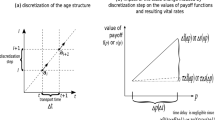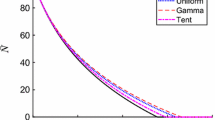Abstract
Nonoverlapping generations have been classically modelled as difference equations in order to account for the discrete nature of reproductive events. However, other events such as resource consumption or mortality are continuous and take place in the within-generation time. We have realistically assumed a hybrid ODE bidimensional model of resources and consumers with discrete events for reproduction. Numerical and analytical approaches showed that the resulting dynamics resembles a Ricker map, including the doubling route to chaos. Stochastic simulations with a handling-time parameter for indirect competition of juveniles may affect the qualitative behaviour of the model.
Similar content being viewed by others
References
Blair, J. M. (1997). Fire frequency affects soil N availability and plant responses to subsequent fires in tallgrass prairie: a test of the transient maxima hypothesis. Ecology 78, 2359–2368.
Gurney, W. S. C., S. P. Blythe and R. M. Nisbet (1980). Nicholson’s blowflies revisited. Nature 287, 17–21.
Gurney, W. S. C. and R. M. Nisbet (1998). Ecological Dynamics, Oxford: Oxford University Press.
Gyllenberg, M., I. Hanski and T. Lindstrom (1997). Continuous versus discrete single species population models with adjustable reproductive strategies. Bull. Math. Biol. 59, 679–705.
Hassell, M. P., J. H. Lawton and R. M. May (1976). Patterns of dynamical behaviour in single species populations. J. Anim. Ecol. 45, 471–486.
Kuznetsov, Y. A., S. Muratori and S. Rinaldi (1992). Bifurcations and chaos in a periodically forced predator-prey model. Int. J. Bif. Chaos 2, 117–128.
Lande, R. (1987). Extinction thresholds in demographic models of territorial populations. Am. Nat. 130, 624–635.
Mackey, M. C. and L. Glass (1977). Oscillations and chaos in physiological control systems. Science 197, 287–289.
May, R. M. (1974). Biological populations with non-overlapping generations: stable points, stable cycles and chaos. Science 186, 645–647.
May, R. M. (1976). Simple mathematical models with very complicated dynamics. Nature 261, 459–467.
Noy-Meir, I. (1979). Structure and function of desert ecosystems. Isr. J. Bot. 28, 1–9.
Press, W. H., B. P. Flannery, S. A. Teukolsky and W. T. Vetterling (1993). Numerical Recipes in Fortran 77: The Art of Scientific Computing, 2nd edn, Cambridge, UK: Cambridge University Press.
Ricker, W. E. (1954). Stock and recruitment. J. Fish. Res. Bd. Can. 11, 559–623.
Solé, R. V., J. G. P. Gamarra, M. Ginovart and D. López (1999). Controlling chaos in ecology: from deterministic to individual-based models. Bull. Math. Biol. 61, 1187–1207.
Sumpter, D. J. T. and D. S. Broomhead (2001). Relating individual behaviour to population dynamics. Proc. R. Soc. Lond. B 268, 925–932.
Wilson, G. W. (1998). Resolving discrepancies between deterministic population models and individual-based simulations. Am. Nat. 151, 116–134.
Author information
Authors and Affiliations
Rights and permissions
About this article
Cite this article
Gamarra, J.G.P., Solé, R.V. Complex discrete dynamics from simple continuous population models. Bull. Math. Biol. 64, 611–620 (2002). https://doi.org/10.1006/bulm.2002.0286
Received:
Accepted:
Issue Date:
DOI: https://doi.org/10.1006/bulm.2002.0286




